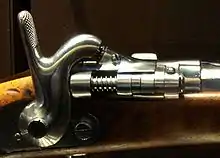Tabatière rifle
The Tabatière rifle was a breech-loading rifle of the French Army.


The Tabatière system was developed from 1864 as a way to convert numerous muzzle-loading weapons (usually Minié rifles) into breech-loading ones, in a process similar to that of the Snider-Enfield in Great Britain or the Springfield Model 1866 in the United States. The name "Tabatière" comes from the fact that the breech-loading mechanism looked like a snuff box.[1]

Most of the conversion work had been accomplished by the time of the Franco-Prussian War.[1] By July 1870, roughly 358.000 rifles had been converted, while 1.4 million muzzleloaders stayed in their original configuration.[2]
The ammunition was a center fire cartridge closely resembling a shortened 12 gauge shotgun shell. This weapon system was recognized as ballistically inferior to the Chassepot rifle, therefore it was used by second line troops and in defensive roles.[1]
These are commonly encountered today as "Zulu Guns", after rifles were converted into shotguns and sold cheaply in the early 1900s.
Models
- Tabatière rifle model 1867.[3]
| Preceded by Minié rifle |
French Army rifle 1864–1870 |
Succeeded by Chassepot |
